We’re about to transform your weeknight dinner routine with this authentic Thai beef curry recipe that’ll transport your taste buds straight to the bustling streets of Bangkok. This rich and aromatic curry combines tender chunks of beef with a fragrant blend of traditional Thai spices that create layers of complex flavors in every single bite.
What makes this dish truly special isn’t just its incredible taste – it’s surprisingly simple to prepare at home. We’ve perfected this recipe to deliver restaurant-quality results using ingredients you can easily find at your local grocery store. The secret lies in building the curry paste from scratch and allowing the beef to slowly simmer until it’s melt-in-your-mouth tender.
Whether you’re a Thai food enthusiast or someone looking to expand their culinary horizons this homemade Thai beef curry will quickly become your new go-to comfort food. Let’s jump into creating this warming and satisfying meal that’s perfect for any occasion.
Ingredients
Creating this aromatic Thai beef curry starts with gathering the right ingredients to build layers of authentic flavor. We’ve organized our ingredient list into four categories to make your preparation seamless and efficient.
For the Curry Paste
- 6 dried red chilies, stems removed and seeded
- 3 shallots, roughly chopped
- 4 garlic cloves, peeled
- 2 inch piece fresh galangal, peeled and sliced
- 2 lemongrass stalks, tender white parts only, chopped
- 3 kaffir lime leaves, stems removed
- 1 teaspoon coriander seeds, toasted
- 1 teaspoon cumin seeds, toasted
- 1 teaspoon white peppercorns
- 1 tablespoon shrimp paste
- 1 teaspoon salt
For the Curry Base
- 2 tablespoons coconut oil or vegetable oil
- 1 can (14 oz) coconut milk, divided
- 2 tablespoons palm sugar or brown sugar
- 3 tablespoons fish sauce
- 2 tablespoons tamarind paste
- 1 cup beef stock or water
- 3 kaffir lime leaves, torn
For the Beef and Vegetables
- 2 pounds beef chuck roast, cut into 2 inch cubes
- 1 large onion, cut into thick wedges
- 1 red bell pepper, cut into strips
- 1 cup green beans, trimmed and cut into 2 inch pieces
- 8 oz baby potatoes, halved
- 1 Asian eggplant, cut into chunks
- 2 Thai basil sprigs, leaves only
Garnish and Serving
- 4 cups cooked jasmine rice
- Fresh Thai basil leaves
- Sliced red chilies
- Lime wedges
- Coconut milk for drizzling
Equipment Needed
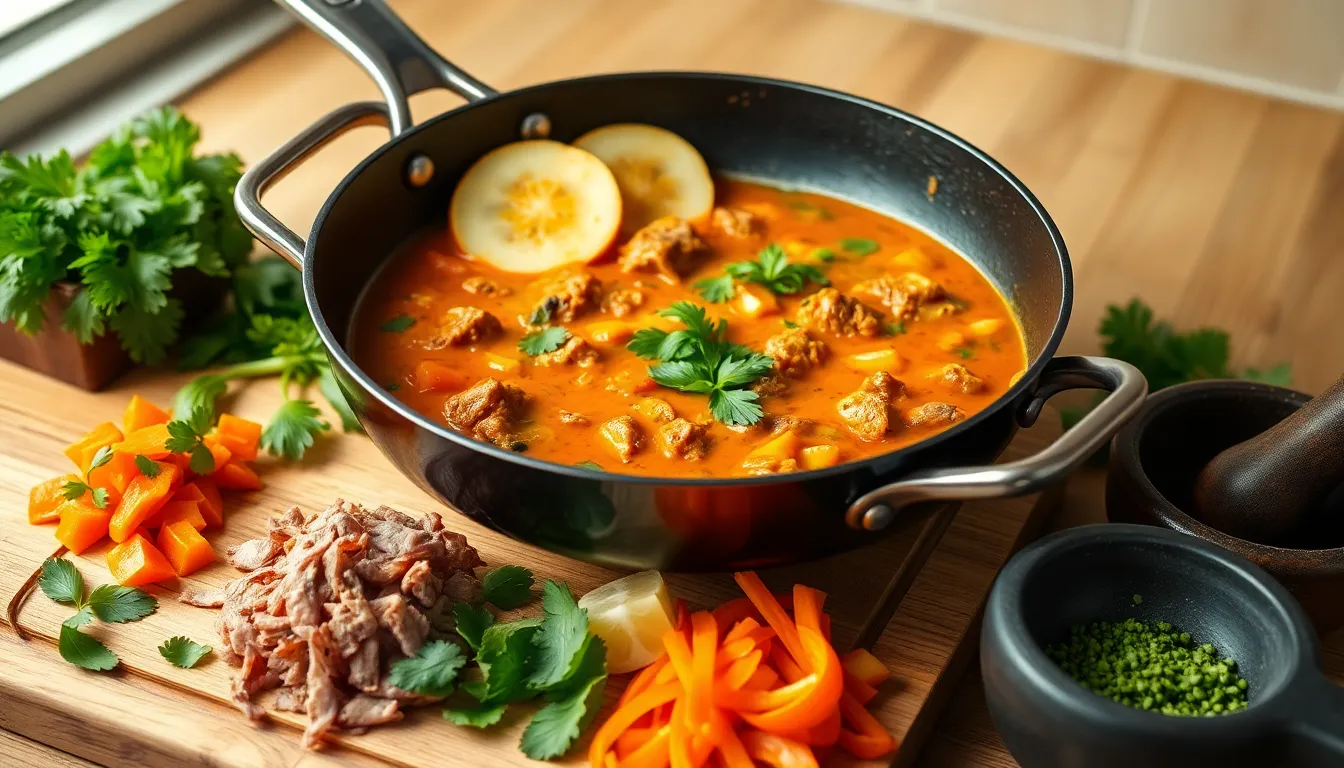
Creating this aromatic Thai beef curry requires exact kitchen tools that will help us achieve restaurant-quality results at home. We’ve organized the essential equipment based on the different stages of preparation to ensure our cooking process flows smoothly.
Large Skillet or Wok
Our primary cooking vessel needs to accommodate sautéing vegetables, browning meat, and simmering the entire curry sauce. A large skillet or traditional wok provides the necessary surface area for proper heat distribution and ingredient movement during cooking.
Mortar and Pestle
Making authentic curry paste from scratch demands this traditional grinding tool. The mortar and pestle allows us to break down dried chilies, coriander seeds, cumin seeds, and other spices into a smooth, fragrant paste that forms the foundation of our curry.
Sharp Knife and Cutting Board
Precision cutting ensures even cooking throughout our curry. We’ll use these tools to slice beef against the grain, dice vegetables uniformly, and prepare fresh herbs for garnishing.
Measuring Tools
Accurate measurements create the perfect balance of flavors in Thai cuisine. Our measuring spoons and cups help us portion coconut milk, curry paste, fish sauce, palm sugar, and spices with precision.
Cooking Utensils
A sturdy spatula or wooden spoon becomes essential for stirring the curry without scratching our cookware. These tools help us incorporate ingredients smoothly and prevent sticking during the simmering process.
Serving Equipment
Proper presentation enhances the dining experience. We’ll need serving bowls for the curry, plates for jasmine rice, and small dishes for garnishes like fresh chilies, lime wedges, and additional coconut milk.
Having these tools ready before we begin cooking ensures our Thai beef curry preparation moves efficiently from start to finish.
Prep Work

Proper preparation forms the foundation of exceptional Thai beef curry. We’ll walk through each essential step to ensure our curry develops the rich flavors and tender textures that make this dish irresistible.
Preparing the Beef
We recommend using stewing beef such as chuck or rump steak for optimal results since these cuts become incredibly tender when cooked slowly. Cut the beef into bite-sized pieces to ensure even cooking throughout the simmering process.
Before adding the beef to our curry base we brown it in batches with a bit of oil. This crucial step develops deep flavor and creates the perfect texture that will complement our aromatic curry sauce. The browning process caramelizes the meat’s surface and locks in juices that will enhance the overall richness of our dish.
Prepping the Vegetables
Our aromatic foundation begins with onion garlic and ginger which we slice or mince finely to release maximum aroma and flavor. These essential aromatics create the base notes that support our curry’s complex flavor profile.
Winter squash varieties like butternut kabocha or red kuri add natural sweetness and help thicken our curry sauce. We peel and cube these squashes before adding them to the pot where they’ll break down slightly during cooking. Bell peppers should be sliced thinly to provide texture and vibrant color that makes our curry visually appealing.
Making Fresh Curry Paste
Traditional curry paste delivers unmatched flavor when we blend fresh ingredients including dried chilies coriander seeds cumin seeds white peppercorns lemongrass ginger galangal garlic and shallots. The difference between fresh and store-bought paste becomes immediately apparent in the final dish.
We toast spices like cumin and coriander seeds before grinding to develop deeper flavor complexity. Using a mortar and pestle or high-powered blender we pound or blend all ingredients into a smooth paste. Red curry paste works best for Thai beef curry and can be used immediately or stored refrigerated for future use.
Our fresh curry paste becomes the heart of authentic Thai flavor that transforms ordinary ingredients into an extraordinary meal.
Instructions
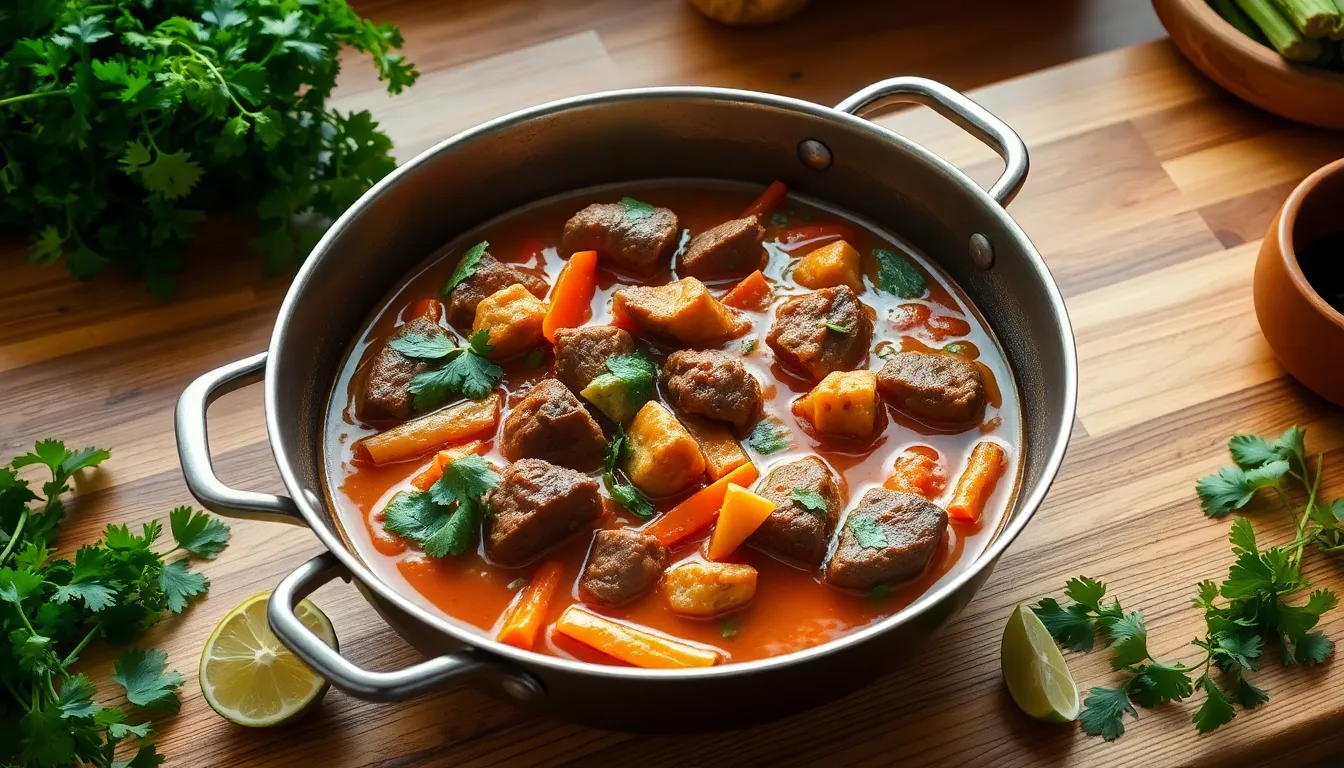
We’ll guide you through each step to create this authentic Thai beef curry that delivers restaurant-quality results in your own kitchen. Our methodical approach ensures perfect flavor balance and tender beef every time.
Step 1: Prepare the Curry Base
Heat coconut oil in a large skillet or wok over medium heat until shimmering. Add sliced onion and cook for 3-4 minutes until softened and translucent. Stir in minced garlic and grated ginger, cooking for another minute until fragrant.
Add your freshly made curry paste or 2 tablespoons of Thai red curry paste to the pan. Cook the mixture for 2-3 minutes, stirring constantly to prevent burning. The paste should become fragrant and slightly darker in color. Add thinly sliced lemongrass stalks and continue cooking until the aromatic base fills your kitchen with authentic Thai scents.
Step 2: Cook the Beef
Remove the curry base mixture from the pan temporarily and set aside. Increase heat to medium-high and add more oil if needed. Working in batches to avoid overcrowding, brown the beef chuck pieces on all sides for 2-3 minutes per batch.
Each piece should develop a golden crust that locks in flavor and creates depth in the final dish. Return all browned beef to the pan along with the curry base mixture. Stir everything together to coat the meat evenly with the aromatic paste.
Step 3: Add Vegetables and Seasonings
Pour in 3/4 cup coconut milk and 1/2 cup water, scraping up any browned bits from the bottom of the pan. Add 1/2 teaspoon beef bouillon granules and 1 teaspoon sugar, stirring until dissolved.
Incorporate 1 teaspoon fish sauce for authentic saltiness and umami depth. The liquid should just cover the beef pieces. If needed, add more water or coconut milk to achieve proper coverage.
Step 4: Simmer and Finish
Bring the curry to a rolling boil, then reduce heat to low and cover the pan. Allow the curry to simmer gently for 1 hour, checking occasionally and adding liquid if needed. Remove the lid and continue cooking uncovered for another 45 minutes until the beef becomes fork-tender.
Stir in 1 tablespoon fresh lime juice, 200ml coconut cream, and 1/4 cup chopped fresh coriander during the final 5 minutes of cooking. Taste and adjust seasonings with additional fish sauce, sugar, or lime juice as desired. Heat through completely before serving over fragrant jasmine rice.
Cooking Tips and Techniques
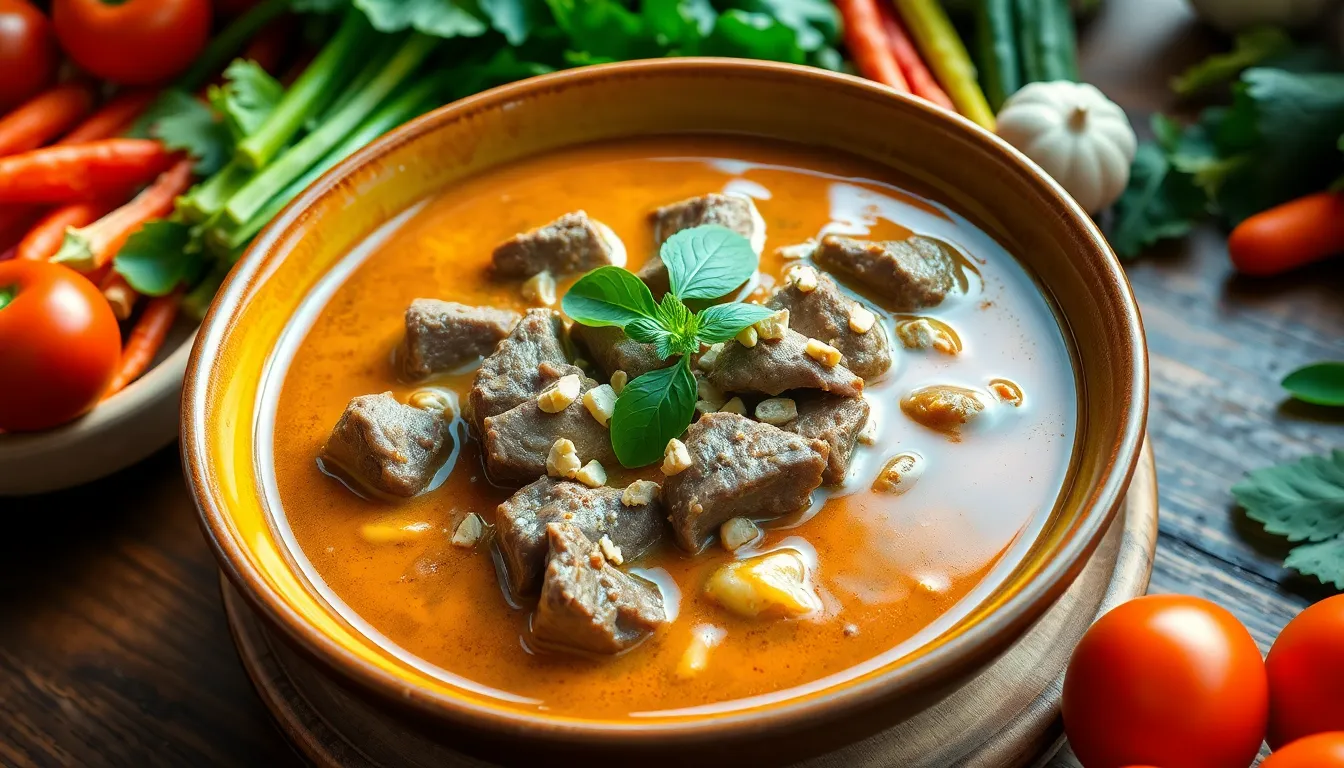
Mastering Thai beef curry requires understanding several key techniques that transform simple ingredients into an exceptional dish. These proven methods ensure restaurant-quality results every time we prepare this aromatic curry.
Choosing the Right Cut of Beef
We recommend selecting tender cuts that respond well to quick cooking methods for optimal results. Top sirloin, ribeye, or flank steak work exceptionally well when thinly sliced against the grain, which helps tenderize the meat and allows for quick, even cooking in our curry.
Thin slicing against the grain breaks down muscle fibers and creates the perfect texture for stir-fry style curry preparations. We avoid excessively tough or chewy cuts unless planning extended slow cooking, as thin slices naturally reduce chewiness and improve the overall eating experience.
Marinating our beef briefly with fish sauce and oil before cooking adds both tenderness and deep umami flavor. This simple step breaks down proteins while infusing the meat with authentic Thai taste that enhances our finished curry.
Balancing Flavors
Thai beef curry achieves its distinctive taste through careful balance of four essential flavor elements: spicy, sweet, salty, and sour. We build spiciness from red curry paste and fresh chiles, while palm sugar or brown sugar provides the necessary sweetness.
Fish sauce contributes both salty and umami depth to our curry base. Sourness comes from lime juice or kaffir lime leaves, creating the bright acidity that makes Thai cuisine so appealing.
We always adjust seasoning after cooking by tasting and adding fish sauce or sugar as needed to achieve perfect balance. Fresh herbs like Thai basil and garnishes such as chopped peanuts add aromatic contrast and textural variety that elevates our finished dish.
Achieving the Perfect Consistency
Creating the ideal curry consistency begins with reducing part of our coconut milk until thick and creamy before adding curry paste. This technique builds a rich base that prevents separation and creates smooth, luxurious sauce texture.
We gradually add remaining coconut milk and water if needed to reach a slightly thick consistency that coats beef and vegetables without becoming too runny or oily. Cooking our curry paste in coconut milk until oil separates enhances flavor depth, while deglazing the pan with coconut milk prevents sticking.
Gentle simmering helps thicken our sauce without curdling the coconut milk, ensuring smooth consistency throughout cooking. We maintain vegetables at tender-crisp texture to provide pleasant contrast against the rich curry sauce, creating the perfect balance of flavors and textures.
Serving Suggestions
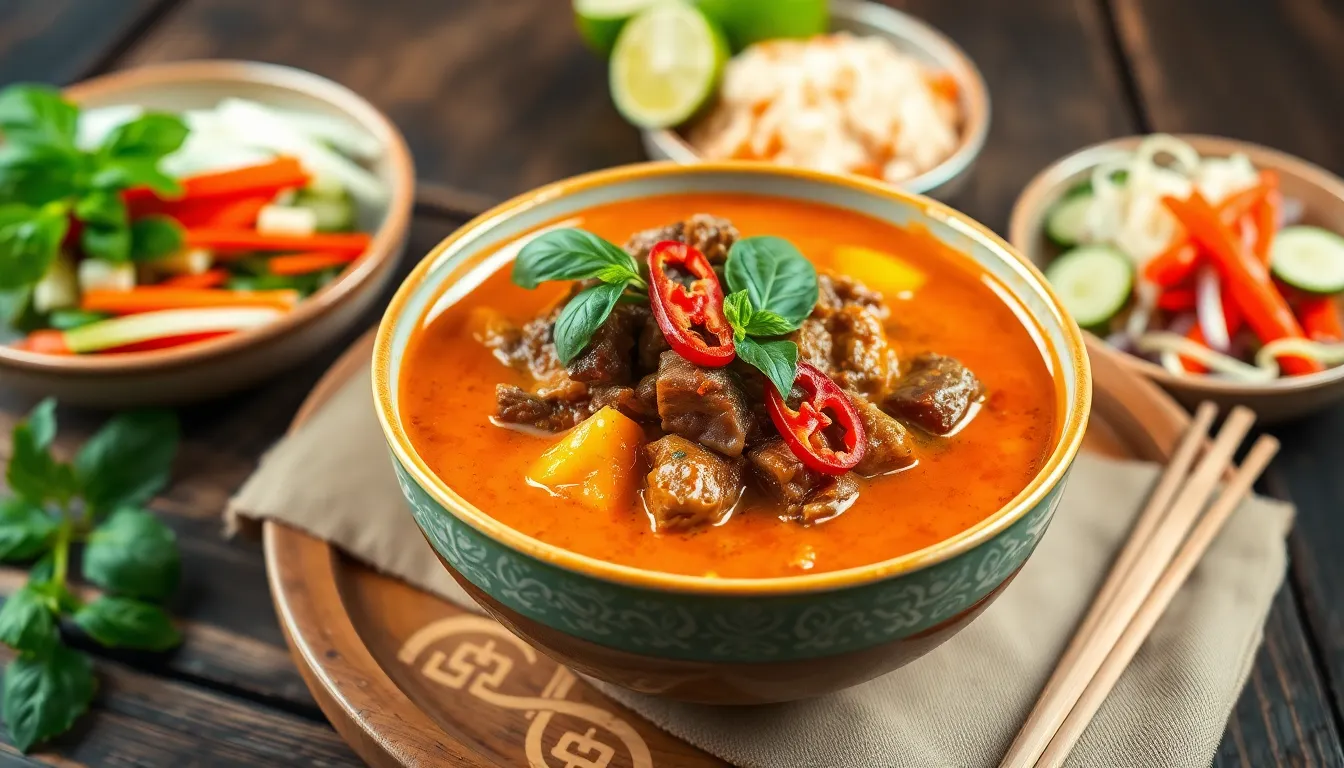
Jasmine rice serves as the perfect foundation for our Thai beef curry. We recommend steaming the rice until it’s fluffy and fragrant, creating an ideal base that absorbs the rich curry flavors without competing with them. The neutral taste of jasmine rice allows the complex spices and coconut milk to shine through each bite.
Fresh herbs transform this dish from good to extraordinary. Thai basil leaves scattered over the top add a bright, peppery note that cuts through the richness. We love adding torn mint leaves for their cooling effect, especially when the curry has a bit of heat. These fresh elements provide textural contrast and aromatic lift that makes each spoonful more captivating.
Garnish combinations elevate the visual appeal and flavor complexity of our curry. Julienned kaffir lime leaves release their citrusy fragrance when sprinkled over the hot curry. Thinly sliced red chilies add both color and an optional heat boost for those who enjoy extra spice. A drizzle of coconut cream creates beautiful presentation while enriching the already luxurious sauce.
Side dishes help balance the intensity of our Thai beef curry. Steamed vegetables like broccoli or snap peas provide freshness and crunch. A simple cucumber salad dressed with rice vinegar offers cooling relief between bites of the rich curry. These lighter accompaniments prevent palate fatigue and create a more complete meal experience.
Temperature and timing matter significantly for optimal enjoyment. We serve our curry piping hot immediately after cooking to preserve the aromatic oils and ensure the beef remains tender. The coconut milk should still be glossy and the herbs should retain their vibrant color when plated.
Portion considerations help create satisfying servings for different appetites:
| Serving Size | Curry Amount | Rice Amount | Additional Sides |
|---|---|---|---|
| Light meal | 1 cup | ½ cup | Fresh herbs only |
| Regular meal | 1.5 cups | ¾ cup | Herbs + vegetables |
| Hearty meal | 2 cups | 1 cup | Full garnish spread |
Presentation tips make our homemade curry look restaurant worthy. We ladle the curry around the rice rather than over it, allowing guests to mix as desired. Lime wedges served alongside encourage diners to adjust acidity to their preference. The final squeeze of lime brightens the entire dish and activates the aromatic compounds in our carefully balanced curry.
Storage and Reheating Instructions
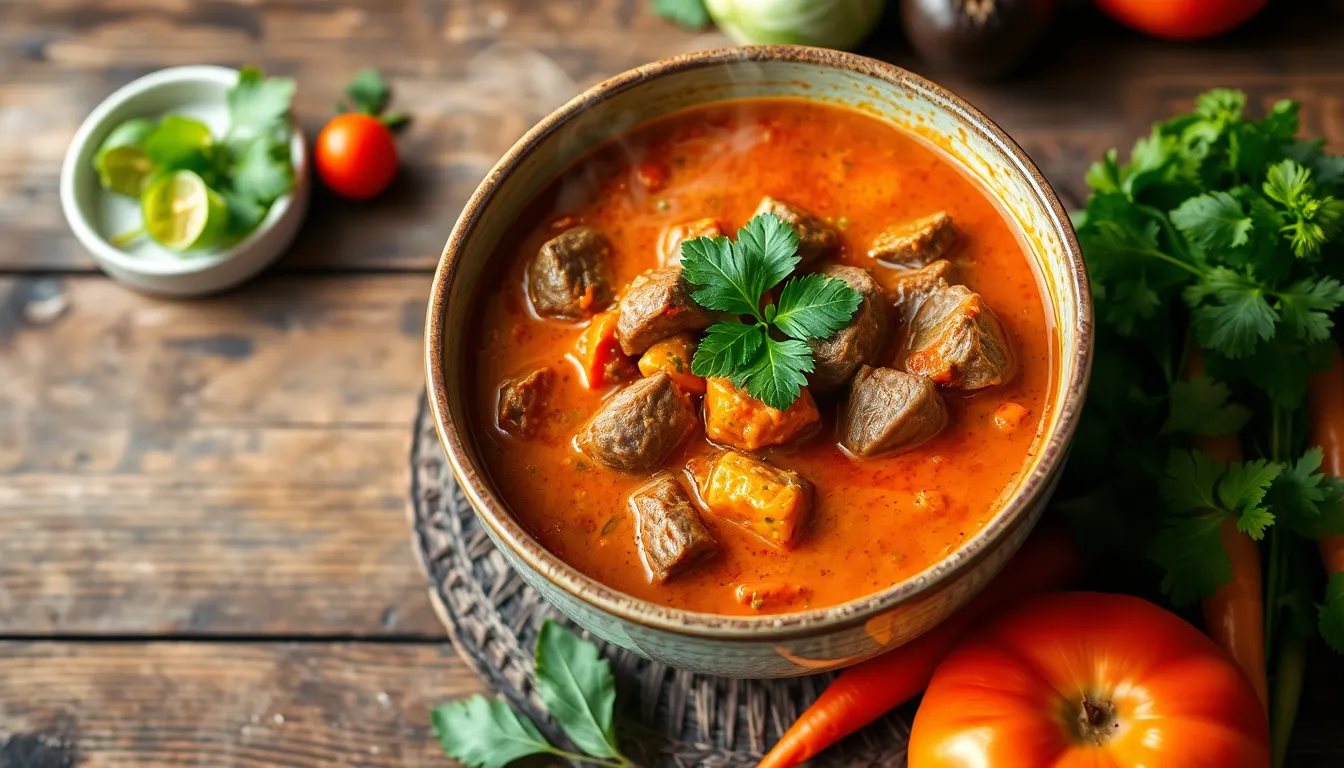
Our delicious Thai beef curry tastes even better the next day as the flavors continue to develop and meld together. Proper storage ensures we can enjoy this aromatic dish for several days while maintaining its rich texture and bold flavors.
Proper Storage Methods
We should allow our cooked Thai beef curry to cool completely to room temperature before storing. This prevents condensation from forming inside the container which could affect the curry’s quality. Transfer the cooled curry to airtight containers and refrigerate immediately.
Our curry maintains its best quality when stored in the refrigerator for up to 3-4 days. For longer storage periods we can freeze the curry in airtight freezer-safe containers or heavy-duty freezer bags for up to 2-3 months. Label containers with the date to track freshness and ensure we use the oldest portions first.
| Storage Method | Duration | Container Type |
|---|---|---|
| Refrigerator | 3-4 days | Airtight containers |
| Freezer | 2-3 months | Freezer-safe containers or bags |
Reheating for Best Results
We achieve the best results when reheating our refrigerated curry gently over medium-low heat on the stovetop. Stir occasionally until heated through to ensure even warming throughout. The curry may thicken during storage so we add a splash of water or coconut milk if the sauce becomes too thick.
Avoid boiling the curry vigorously as this can break down the coconut milk and affect the tender beef texture. We want to preserve the smooth creamy consistency that makes this dish so appealing.
Reheating from Frozen
Frozen curry requires special attention for optimal results. We recommend thawing overnight in the refrigerator before reheating using the stovetop method above. This ensures even heating and maintains the curry’s rich texture.
For quicker reheating we can use the microwave with frozen curry. Place the curry in a microwave-safe dish and heat in short intervals stirring between each to ensure even heating. This prevents hot spots that could overcook the beef or cause the sauce to separate.
Final Touches After Reheating
Fresh herbs lose their vibrancy during storage and reheating. We always garnish our reheated curry with fresh coriander and Thai basil after warming to restore that bright fresh flavor. A squeeze of lime juice also brightens the dish and brings back the authentic Thai taste profile we worked so hard to achieve.
Recipe Variations
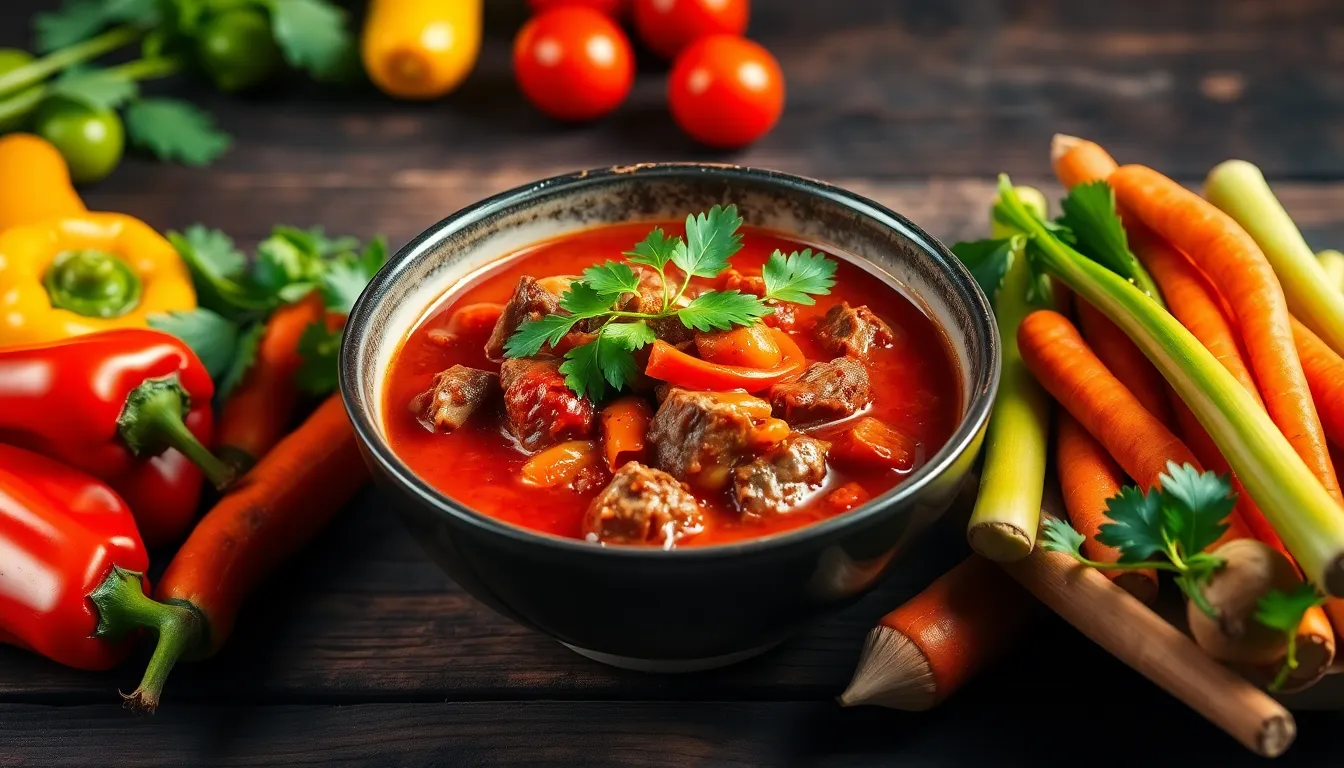
We can transform our Thai beef curry into exciting variations that showcase different flavor profiles and ingredients. Each variation offers unique characteristics while maintaining the soul of authentic Thai cuisine.
Red Curry Version
Red curry paste forms the foundation of our most popular variation. We combine garlic, ginger, and lemongrass with the red curry paste to create a rich aromatic base. The paste delivers deep spicy flavors that develop beautifully when sautéed in oil before adding the beef.
Coconut milk creates the creamy texture that balances the heat from the red chilies. We simmer the beef in this coconut milk base for optimal tenderness and flavor absorption. Fish sauce and lime juice provide the essential salty and tangy elements that complete the flavor profile.
Fresh coriander adds brightness to the finished dish. We garnish generously with chopped coriander leaves to enhance both visual appeal and flavor complexity.
Green Curry Alternative
Green curry paste offers a spicier and more herbal alternative to red curry. We use fresh green chilies and herbs in this variation for a more intense heat level. The green curry tends to be more aromatic due to the fresh ingredients used in the paste.
Thai basil becomes essential in green curry versions. We add Thai basil leaves during the final minutes of cooking to preserve their delicate flavor and aroma. Eggplant and bamboo shoots work particularly well with green curry paste.
Lean cuts of beef perform excellently in green curry. We can substitute chicken for beef while maintaining the same cooking method and simmering time in coconut milk.
Vegetable Additions
Bell peppers add color and crunch to our curry variations. We include red bell peppers during the sauté phase to maintain their texture and vibrant appearance. Carrots provide natural sweetness that complements the spicy curry paste.
Bamboo shoots offer authentic Thai flavor and unique texture. We add bamboo shoots during the simmering phase so they absorb the curry flavors while maintaining their firm bite. Green beans work similarly and add nutritional value to the dish.
Asian eggplants absorb curry flavors exceptionally well. We cut eggplants into bite-sized pieces and add them during the vegetable cooking phase. These vegetables complement the beef while adding texture and nutrition to create a more complete meal.
Make-Ahead Instructions

Planning ahead transforms your Thai beef curry experience from stressful to spectacular. We recommend several strategic approaches that enhance both flavor and convenience for this beloved dish.
Marinating the Beef
Starting with the beef preparation gives us the biggest flavor advantage. We can marinate the beef pieces with curry paste for up to 8 hours or overnight in the refrigerator. This extended marinating time allows the spices to penetrate the meat deeply, creating more complex flavors throughout every bite. Simply combine the beef with 2-3 tablespoons of curry paste in a sealed container, ensuring all pieces are well coated.
Full Curry Preparation
Preparing the entire curry ahead of time actually improves the dish significantly. Once we complete the cooking process, the curry can be stored in an airtight container in the refrigerator for up to 3 days. During this storage period, the flavors continue to develop and meld together, creating an even richer taste profile than when freshly made.
The curry paste components can also be prepared separately up to one week in advance. We recommend storing the finished paste in the refrigerator in a sealed jar, which maintains its potency and saves considerable prep time on cooking day.
Proper Storage Guidelines
| Storage Method | Duration | Container Type |
|---|---|---|
| Refrigerated Curry | 3 days | Airtight container |
| Marinated Beef | 8 hours overnight | Sealed container |
| Curry Paste | 1 week | Sealed jar |
Reheating Techniques
Gentle reheating preserves the curry’s texture and prevents the coconut milk from separating. We heat the curry on the stovetop over medium-low heat, stirring occasionally to ensure even warming. Adding a splash of coconut milk or water during reheating helps restore the sauce consistency if it has thickened too much during storage.
Never rush the reheating process with high heat, as this can cause the coconut milk to curdle and compromise the smooth texture we worked to achieve. The curry is properly reheated when it reaches serving temperature throughout, typically requiring 8-10 minutes of gentle warming.
Conclusion
We’ve shared everything you need to create an authentic Thai beef curry that rivals your favorite restaurant. This recipe transforms simple ingredients into something extraordinary through careful technique and traditional flavors.
The beauty of this dish lies in its versatility – whether you stick to our classic version or explore the red and green curry variations we’ve outlined. Each approach delivers that perfect balance of spicy sweet salty and sour that makes Thai cuisine so irresistible.
With proper storage techniques and make-ahead options we’ve covered you’ll find this curry becomes even more convenient for busy weeknights. The flavors actually improve over time making it an ideal meal prep option.
Now it’s time to gather your ingredients fire up that stove and bring the authentic taste of Bangkok’s street food to your kitchen. Your family will thank you for this flavorful adventure.
Frequently Asked Questions
What cut of beef is best for Thai beef curry?
Chuck roast, rump steak, or other stewing cuts work best for Thai beef curry. These tougher cuts become tender when simmered slowly in the curry sauce. For quicker cooking, you can use tender cuts like top sirloin or ribeye, but slice them thinly against the grain and add them near the end of cooking.
Can I make Thai curry paste from scratch?
Yes, making curry paste from scratch significantly enhances flavor. Use a mortar and pestle to grind dried red chilies, shallots, garlic, galangal, lemongrass, and kaffir lime leaves with spices. Fresh homemade paste creates unmatched depth compared to store-bought versions and can be stored in the refrigerator for up to a week.
How long does Thai beef curry last in the refrigerator?
Thai beef curry can be stored in the refrigerator for 3-4 days in airtight containers. The flavors actually improve overnight as they meld together. For longer storage, freeze the curry for 2-3 months. Always allow the curry to cool completely before refrigerating or freezing.
What’s the best way to reheat Thai beef curry?
Reheat Thai beef curry gently on the stovetop over low heat, stirring occasionally to prevent the coconut milk from separating. Add a splash of coconut milk or broth if needed to restore consistency. Avoid microwaving at high power as it can cause the sauce to break and affect texture.
Can I make Thai beef curry ahead of time?
Yes, Thai beef curry is perfect for meal prep. You can marinate the beef with curry paste up to 8 hours ahead, or prepare the entire curry and refrigerate for up to 3 days. The flavors develop and improve over time, making it an excellent make-ahead dish for busy weeknights.
What vegetables work best in Thai beef curry?
Traditional vegetables include red bell peppers, green beans, baby potatoes, and Asian eggplant. For variations, try bamboo shoots, carrots, snap peas, or Thai eggplants. Add harder vegetables early in cooking and softer ones later to ensure even cooking and proper texture.
How do I balance the flavors in Thai beef curry?
Thai cuisine focuses on balancing spicy, sweet, salty, and sour elements. Adjust fish sauce for saltiness, palm sugar for sweetness, tamarind paste or lime juice for sourness, and chilies for heat. Taste and adjust seasonings gradually throughout cooking to achieve the perfect balance.
What’s the difference between red and green Thai curry?
Red curry uses dried red chilies and has a rich, deep flavor with moderate heat. Green curry uses fresh green chilies and herbs, creating a spicier, more aromatic dish with brighter flavors. Both work well with beef, but green curry typically has more intense heat and herbal notes.







